Overview
[ Top
| Version B
| Return to H.E.C. Ascenders
]
Version A
(#2014)
Technical Details
I acquired my NTR, Version A from Linko Chen 训连 陈 in 2015.
Version A is 202 mm. tall, 94 mm. wide, 25 mm. thick, and weighs 239 g.
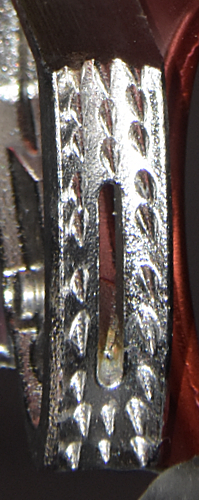 The shell is a tall irregular shaped stamping made from 4.0 mm. aluminum alloy sheet metal. A 15 mm. wide rope channel
is formed in the upper portion of one side and a smaller cam channel
lies opposite the first. A hole drilled through both sides of
the cam channel accepts a 5.5 mm. rivet. The cam and cam spring
are mounted on this rivet. The handle below the cam has a soft
"rubbery" hand grip molded into place. The hand grip
has a slight break to support the index finger. A 16 mm.
sling attachment hole is punched below the handle opening, and
an 11 mm. hole is punched below and outside the first. A
13.5 by 19.5 mm. oval hole punched through both sides
of the rope channel provides an attachment point just above the
cam, and a 15.3 mm. hole beside it provides a second attachment
point.
The shell is a tall irregular shaped stamping made from 4.0 mm. aluminum alloy sheet metal. A 15 mm. wide rope channel
is formed in the upper portion of one side and a smaller cam channel
lies opposite the first. A hole drilled through both sides of
the cam channel accepts a 5.5 mm. rivet. The cam and cam spring
are mounted on this rivet. The handle below the cam has a soft
"rubbery" hand grip molded into place. The hand grip
has a slight break to support the index finger. A 16 mm.
sling attachment hole is punched below the handle opening, and
an 11 mm. hole is punched below and outside the first. A
13.5 by 19.5 mm. oval hole punched through both sides
of the rope channel provides an attachment point just above the
cam, and a 15.3 mm. hole beside it provides a second attachment
point.
The cam is a stainless steel casting with
an open web.
The cam radius increases from 38 to 57 mm. over an angle of 44°, giving a 28° cam angle. The cam has number of small conical teeth, all of which have their axes approximately aligned with the cam axle. The tooth pattern is
(3)^3(1S1)^5(3)^2.
A spring-loaded manual safety tab is mounted on the bottom of the cam with a steel semi-tubular rivet. The normal action of the spring holds the safety against the cam. When the cam is opened, the shell interferes with the safety bar, thus preventing opening the cam. If the safety bar is moved away from the cam (opposing the spring), it will clear the shell and the cam will open. At full open the safety can be released and the spring will hold the safety against the back of the shell. This provides a means of locking the cam open.
The front of ascenders are printed with an up-pointing arrow
above the words "UP," "MAX" and "4kN." To the side is the printed note "ROPE:Ø8-12MM."
The back of the ascenders are printed with "NTR," "CE 1019," and "EN567."
The NTR, Version A is a member of the largest group of similar stamped-frame handled eccentric-cam ascenders in my collection. From a broad perspective, the following ascenders are closely related, with a number of differences (sometimes functionally significant) as indicated:
|
|
| Image |
Ascender |
Frame
Shape |
Frame
Reinforce-
ment? |
Cam Stop |
Cam
Type |
Cam
Safety |
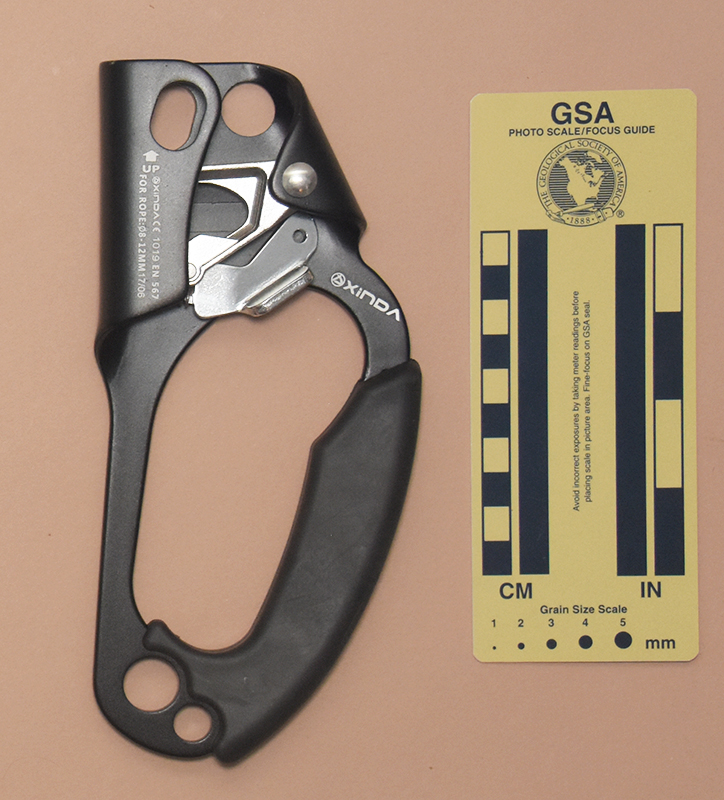 |
Xinda, Version C |
"Fixe" |
No |
No |
Semi-open
Web |
Aluminum
/w Tab |
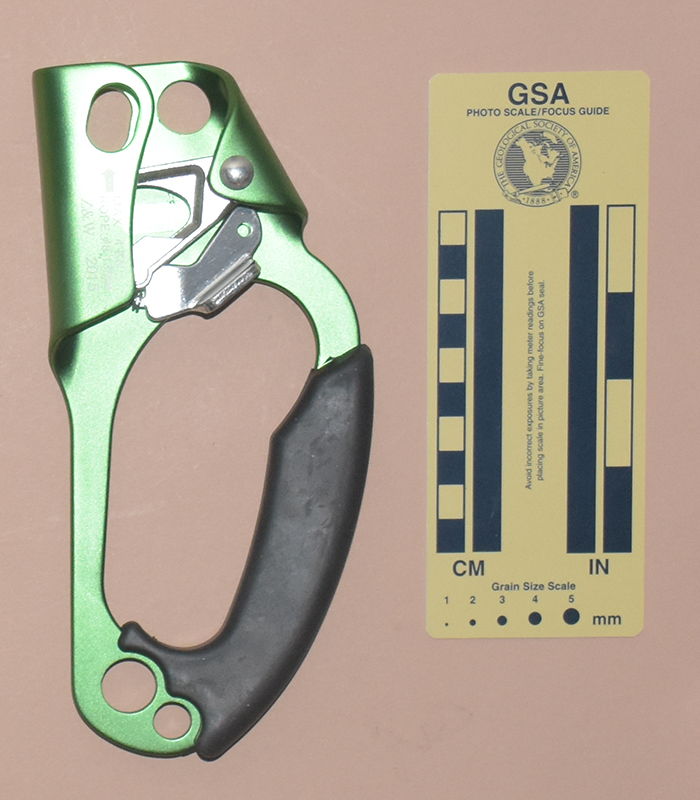 |
Z&W, Version B |
"Fixe" |
No |
No |
Semi-open
Web |
Aluminum
/w Tab |
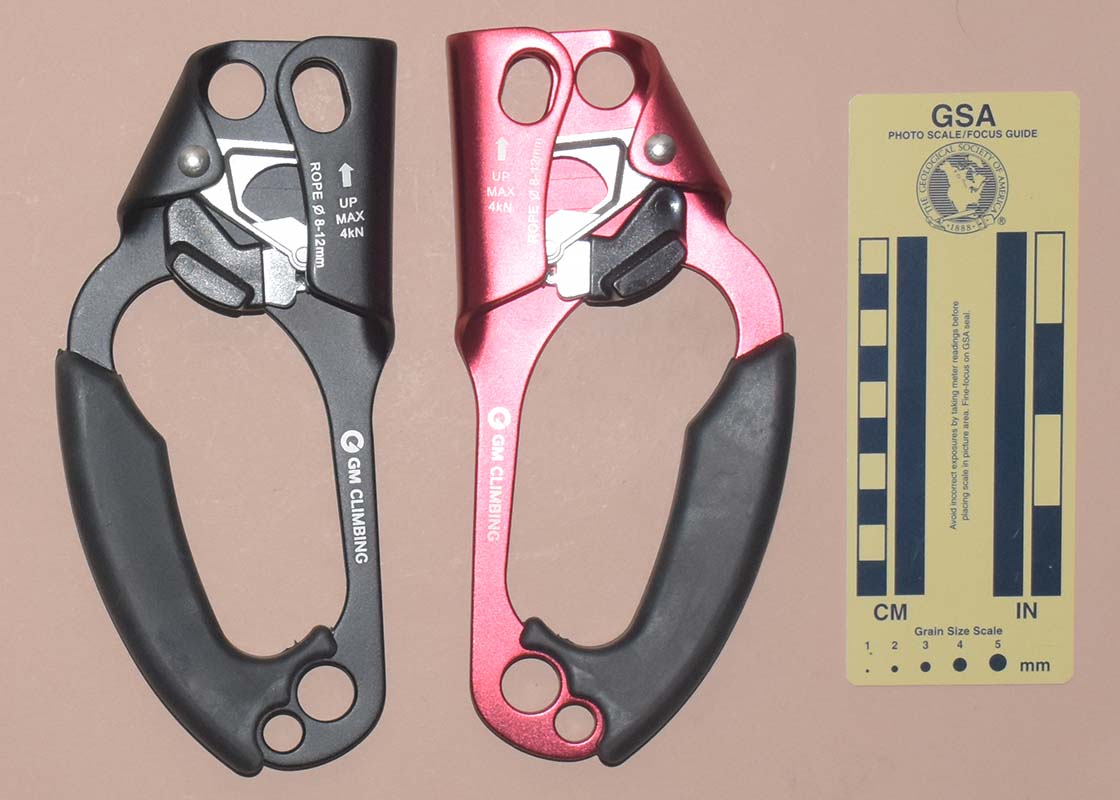 |
GM Climbing
Version B |
"Fixe" |
No |
No |
Semi-open
Web |
Plastic-
covered
Aluminum |
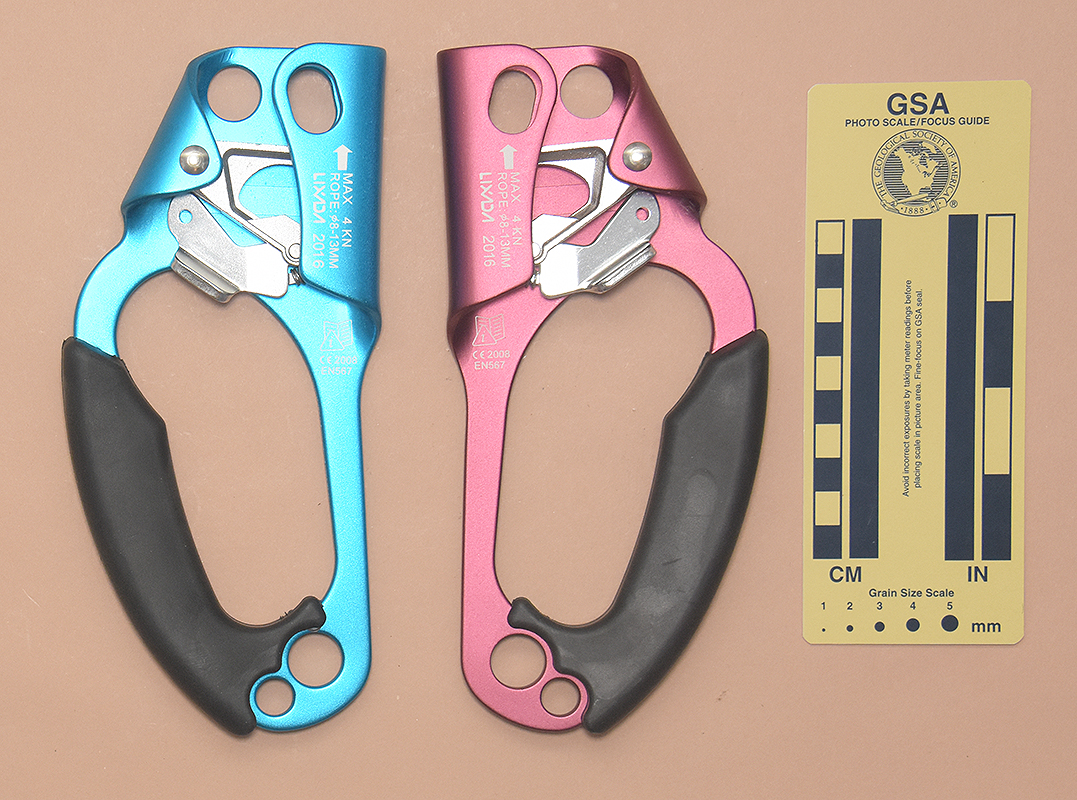 |
Lixada, Version B |
"Fixe" |
No |
No |
"Lixada"
Semi-open
Web |
Aluminum
/w Tab |
 |
Metolius |
"Fixe" |
No |
No |
Asymmetrical
Open-web |
Aluminum
/w Tab |
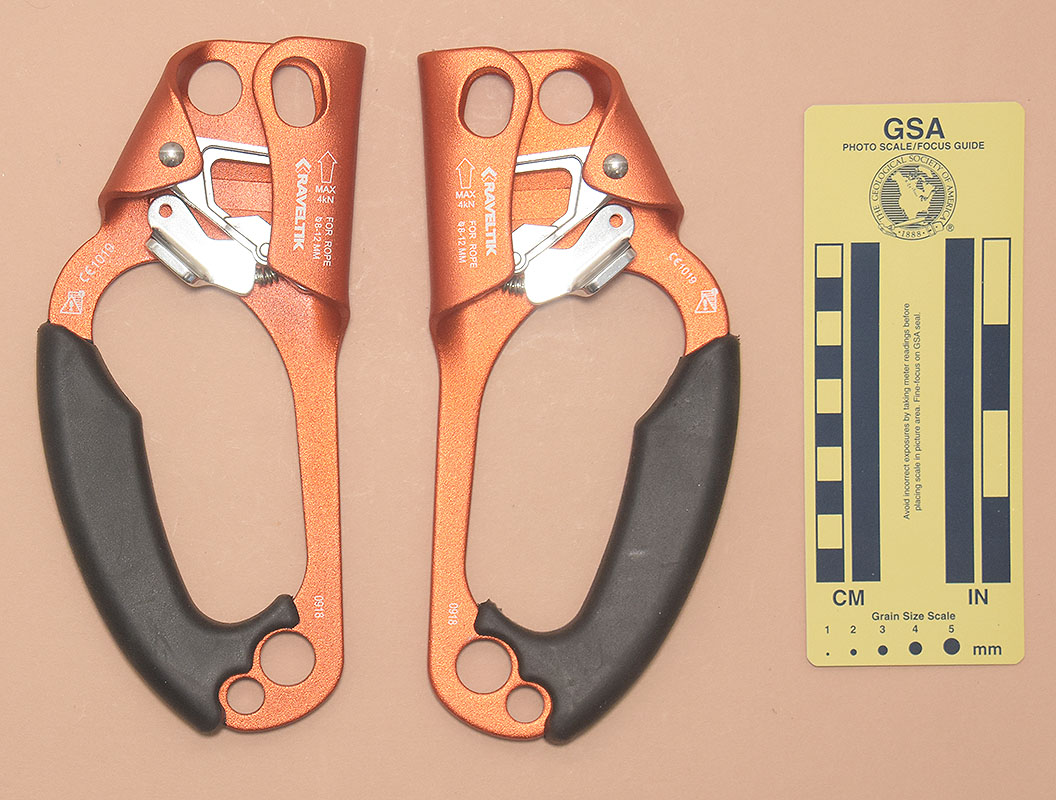 |
Raveltik Sherpa |
"Fixe" |
No |
No |
Asymmetrical
Open-web |
Aluminum
/w Tab |
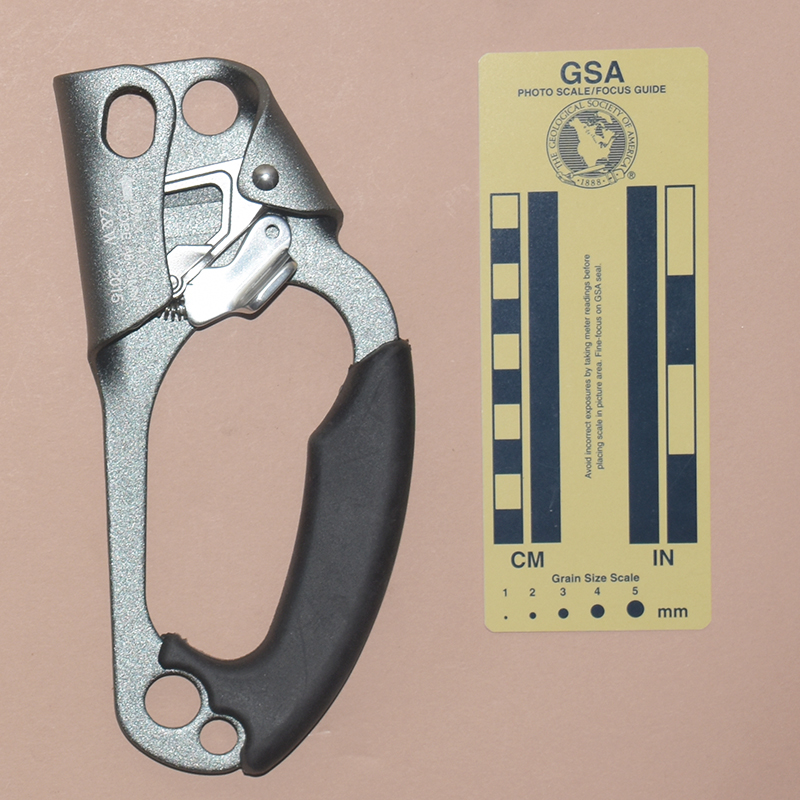 |
Z&W, Version A |
"Fixe" |
No |
No |
Asymmetrical
Open-web |
Aluminum
/w Tab |
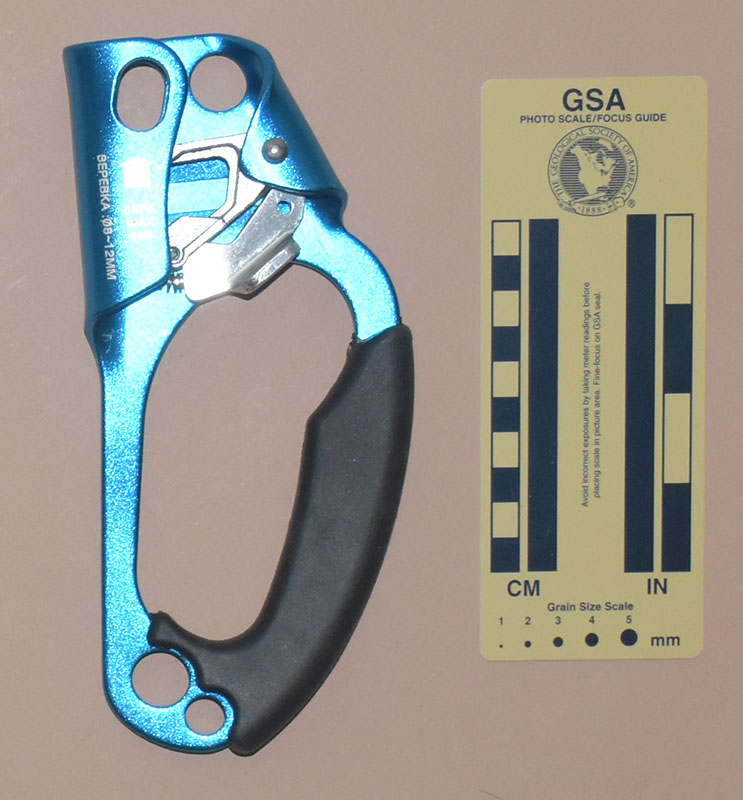 |
Венто (Vento) |
"Fixe" |
No |
No |
Left-handed
Asymmetrical
Open-web |
Aluminum
/w Tab |
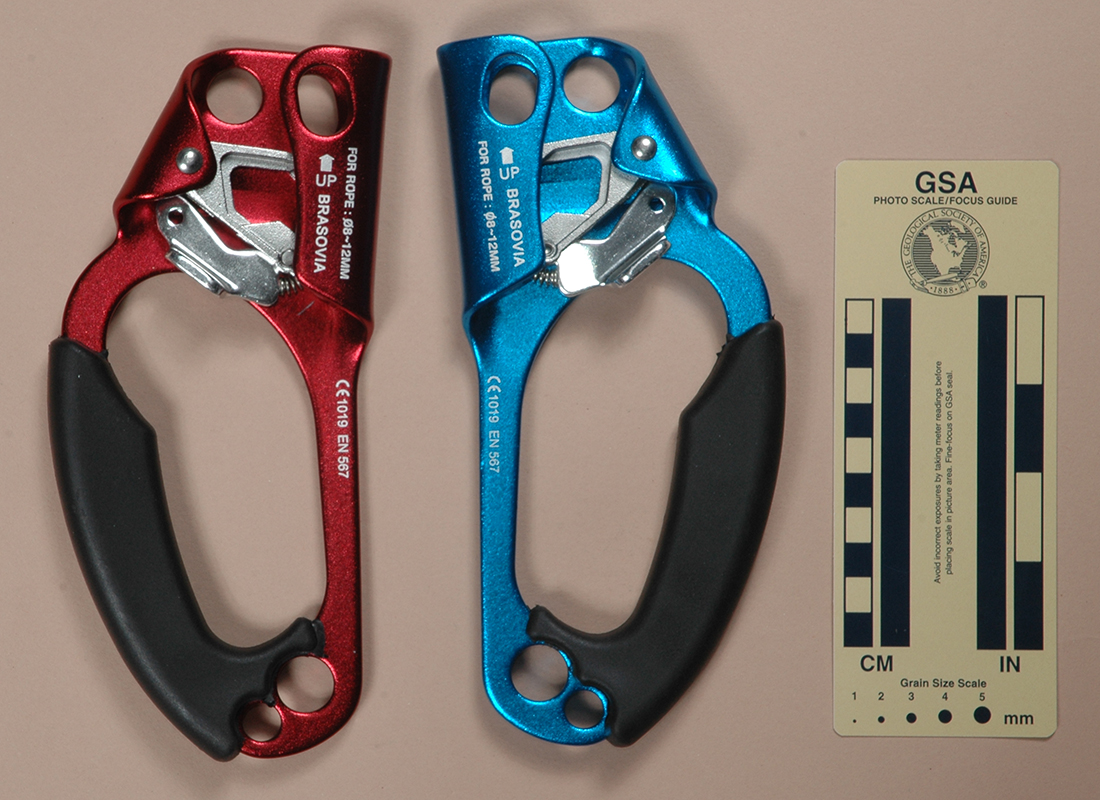 |
Brasovia |
"Fixe" |
No |
No |
Left-handed
Asymmetrical
Open-web |
Aluminum
/w Tab |
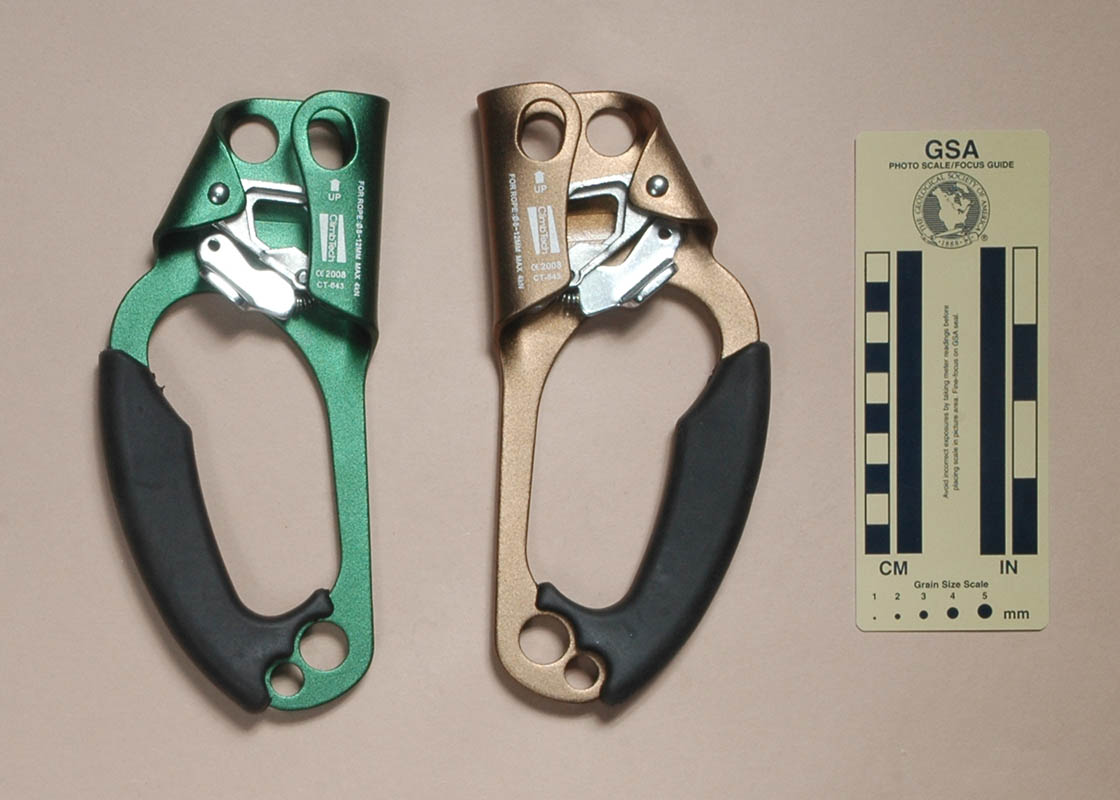 |
Climb Tech |
"Fixe" |
No |
No |
Left-handed
Asymmetrical
Open-web |
Aluminum
/w Tab |
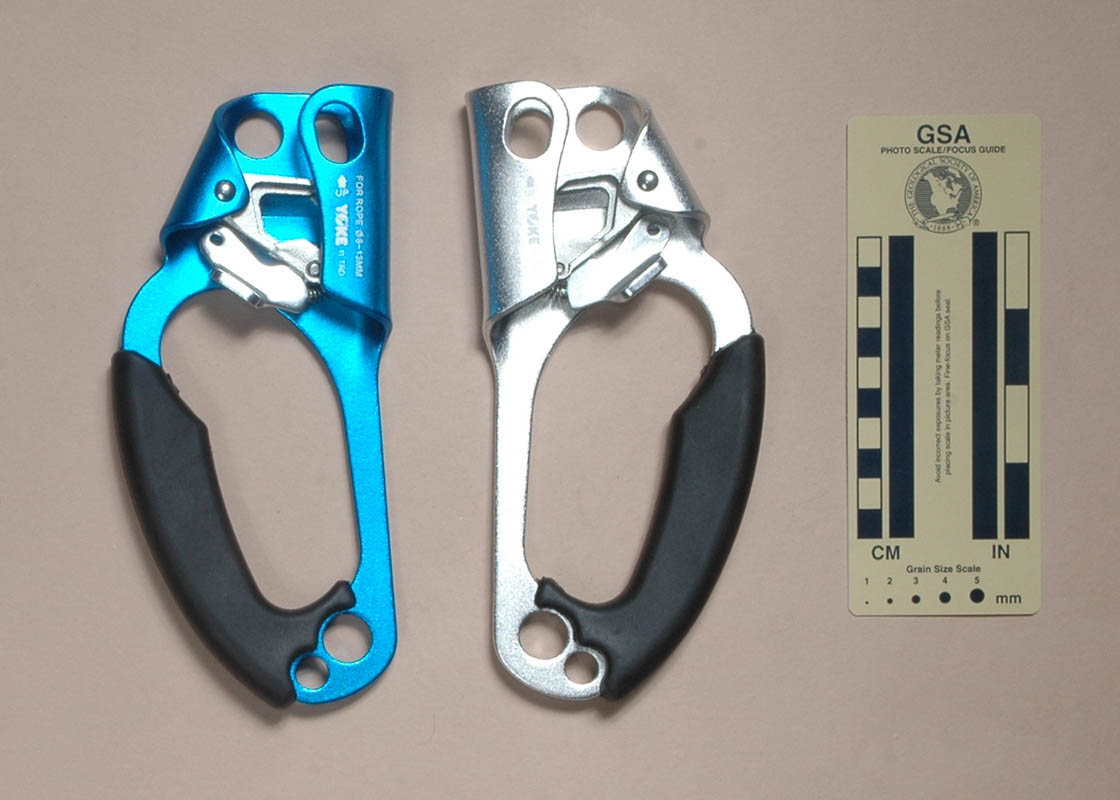 |
Yoke |
"Fixe" |
No |
No |
Left-handed
Asymmetrical
Open-web |
Aluminum
/w Tab |
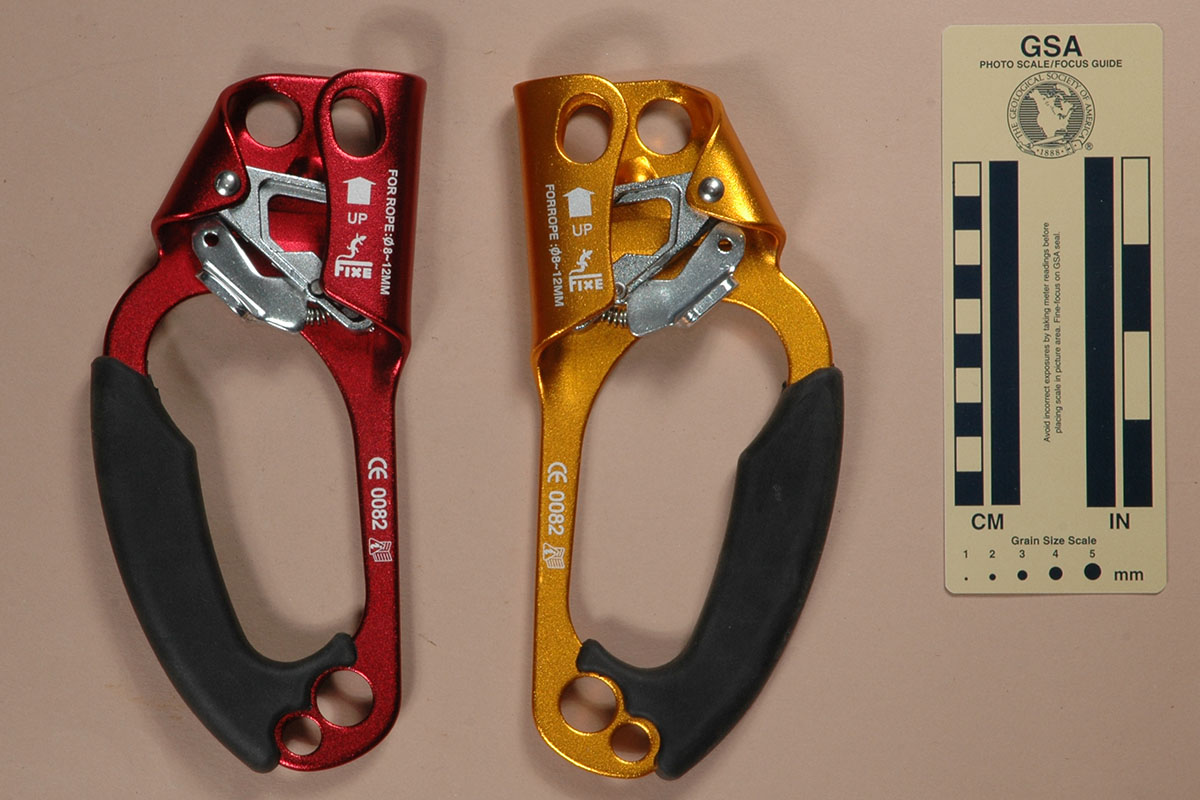 |
Fixe Capitan |
"Fixe" |
No |
Yes |
Left-handed
Asymmetrical
Open-web |
Aluminum
/w Tab |
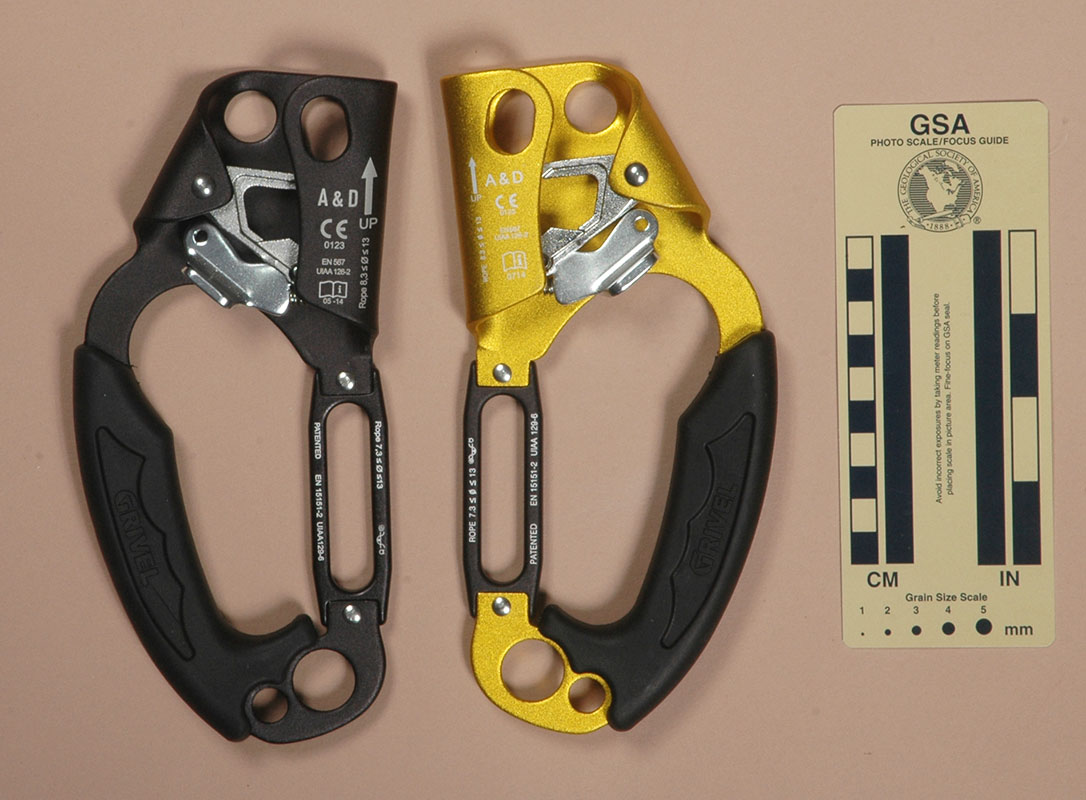 |
Grivel A&D,
Version A |
"Grivel
A&D" |
No |
No |
Left-handed
Asymmetrical
Open-web |
Aluminum
/w Tab |
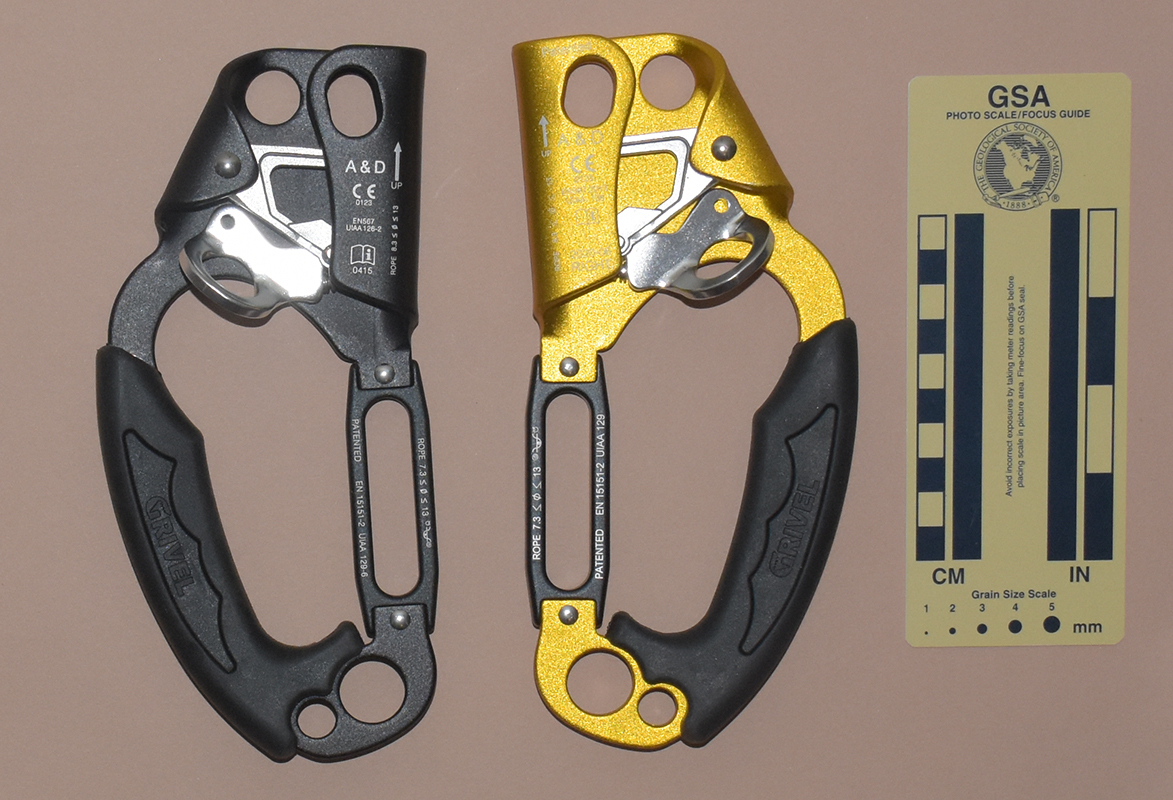 |
Grivel A&D,
Version B |
"Grivel
A&D" |
No |
No |
Asymmetrical
Open-web |
Aluminum
/w Ring |
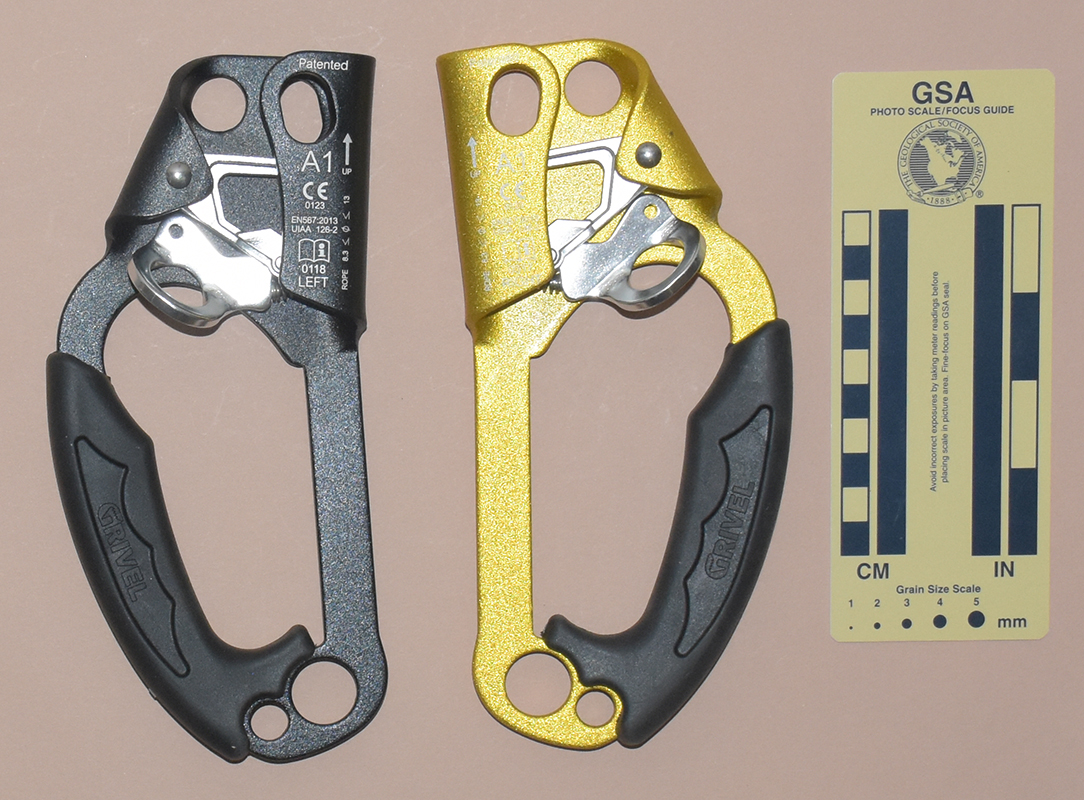 |
Grivel
A1 |
"Grivel
A1" |
No |
No |
Asymmetrical
Open-web |
Aluminum
/w Ring |
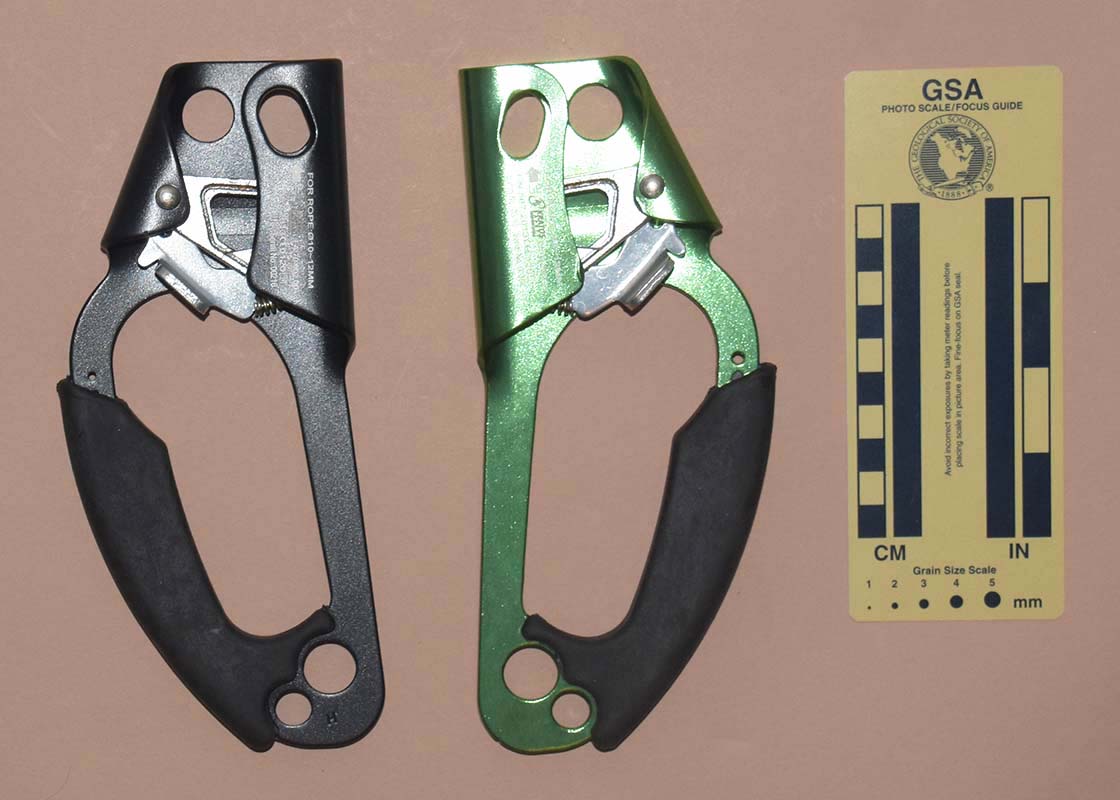 |
Kratos |
"Kratos" |
No |
No |
"Kratos"
Asymmetrical
Open-web |
Aluminum
/w Kratos Tab |
|
These are all well-made ascenders that perform much like the
Petzl Ascension. All sharp edges have been
removed. The attachment points are simple holes
in the shell. In some cases, the user may wish to round the lower attachment holes with a Swiss file; even so, I would consider their small radius too
sharp for directly attaching sling ropes. They are probably acceptably
rounded for webbing (or could be made so with a file), but considering the proximity of the attachment
points to the main rope, I would recommend using a small maillon
for most attachments in order to reduce the risk of sling abrasion.
The lower attachment hole could theoretically have the same safety
problems as the one on Clog Version A.
I'm not sure the extra holes are needed at the base. Except for the Petzl Pompe, I've never found a real need for a second hole. Some people like them, and I might find them more appealing if they were large enough for a standard carabiner to fit through.
The doubled upper rope attachment hole is located very close to the main
rope. A carabiner through the upper oval attachment hole will
probably drag on the main line. The main purpose for this hole is when using the ascender as a safety on a fixed line. The axis of the oval hole is canted so that when trailing the ascender upward, the ascender pulls free of the rope, but it drags a bit if the used falls. I consider this practice dangerous and cannot recommend it. The single upper rope attachment hole, when used in conjunction with the frame side of the double hole, facilitates using the ascender as a chest ascender as shown in the Fixe Capitan instructions.
These ascenders have the same pit lip disadvantage as the Clog and other stamped frame ascenders,
and there is no stamped reinforcing to help prevent bending.
Each has a rubber handle that is comfortable enough for my large hands,
but I don't climb by gripping ascenders at their handle. I think
it is better to simply grasp the ascender from above and lift
the ascender in the traditional manner (unless, of course, you are one of those people who climbs Frog).
With the exception of those on the Kratos, the cams on these ascenders are very well made. Some have open-web cams and others are semi-open. The latter appears to be the later design. I don't think the difference is important. The area behind the cam face is sloped on some of these ("asymmetrical") and not sloped ("symmetrical") on others. Again, I don't think the difference is significant.
The asymmetrical cams have a (3)^3(2)(1S1)^4(3)^2 tooth pattern while the slot in the symmetrical cams is slightly longer (extending to between the top tooth pair), giving a (3)^3(1S1)^5(3)^2 tooth pattern. The Lixada, Version B and Kratos have their own tooth patterns. I don't find that these tooth pattern differences affect cam performance. Some of the models have two identical left-handed cams and some have separate left- and right-handed cams. I do not see any performance difference.
I've heard that the teeth some of these cams wear quickly. I haven't put enough miles on any of these to make a proper comparison, but I would expect the chrome-plated cams on some other brands to last longer than unplated steel cams.
The price for any of these ascenders was much lower than that of American or European ascenders. Some have softer cams that wear faster than American or European equivalents, but lower prices frequently offset the reduced longevity. One potential concern is that we don't have the experience with Chinese metallurgy and quality control that we have with American and European devices. Americans, Europeans, and Chinese all make some high-quality products and some low-quality products. I think that these ascenders are fine and most of them have legitimate CE markings. If I wanted to use a stamped-frame ascender, I would not hesitate to use any of these, but I would like more information and experience with Chinese ascenders before I'm willing to make a final judgement.
The safety is reasonably easy to use with one hand, and the cam opens smoothly.
[ Top
| Version A
| Return to H.E.C. Ascenders
]
Version B
(#2324/3412)
Technical Details
I acquired my left-hand NTR, Version B from Kangjin Liao in 2017, and my right-hand one from eBay seller fmie2718 in 2021.
Version B is 191 mm. tall, 89 mm. wide, 27 mm. thick, and weighs 205 g.
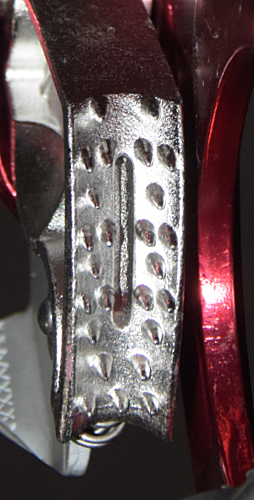 The shell is a tall irregular shaped stamping made from 3.9 mm.
aluminum alloy sheet metal. The upper part of the shell has a stamped reinforcing ridge that extends down into the handle. A 16 mm. rope channel is formed in the upper
portion of one side and a smaller cam channel lies opposite the
first. A hole drilled through both sides of the cam channel accepts
a 5.5 mm. semi-tubular rivet. The cam and cam spring are mounted
on this rivet. The handle below the cam has a soft black rubbery hand grip
molded into place. The hand grip has four finger grooves. A 15.3 mm.
sling attachment hole is punched below the handle opening and a smaller 10.6 mm. hole is punched outside the first. Neither
hole is beveled. A 17.2 mm. hole through both sides
of the rope channel provides an attachment point just above the
cam. This hole is beveled.
The shell is a tall irregular shaped stamping made from 3.9 mm.
aluminum alloy sheet metal. The upper part of the shell has a stamped reinforcing ridge that extends down into the handle. A 16 mm. rope channel is formed in the upper
portion of one side and a smaller cam channel lies opposite the
first. A hole drilled through both sides of the cam channel accepts
a 5.5 mm. semi-tubular rivet. The cam and cam spring are mounted
on this rivet. The handle below the cam has a soft black rubbery hand grip
molded into place. The hand grip has four finger grooves. A 15.3 mm.
sling attachment hole is punched below the handle opening and a smaller 10.6 mm. hole is punched outside the first. Neither
hole is beveled. A 17.2 mm. hole through both sides
of the rope channel provides an attachment point just above the
cam. This hole is beveled.
The cam is a stainless steel casting with a hybrid form consising of a large opening behind the mud slot, a smaller oepning behind this, and a reinforced partial web filling the remainder. The cam radius increases from 36 to 52 mm. over an angle of 38°, giving a 30° cam angle. The cam has number of small conical sloping teeth. The tooth pattern is (2.4)(1S1.2S2)^2(1S1)(2.3) where the "S" represents a single longitudinal mud slot. Like many other ascenders, the inner cam face radius reduces from top to bottom to accommodate various sized ropes.
A spring-loaded manual safety tab is attached to the cam with a semi-tubular rivet. The safety is stamped from 2.5 mm. aluminum alloy. The lower portion is bent outward about 60° to form a thumb tab. The top of the tab has a stamped checkered pattern. The spring is a compression spring that fits over a post on the base of the cam and a small tab on the stamped safety. The normal action of the spring holds the safety against the cam. When the cam is opened, the shell interferes with the safety, thus preventing opening the cam. If the safety is moved away from the cam (opposing the spring), it will clear the shell and the cam will open. At full open the safety can be released and the spring will hold the safety against the back of the shell. This provides a means of locking the cam open.
The front of the ascender is printed with an up-pointing arrow, "UP," "Max 4kn," and "ROPE: Ø8-12MM." The rear is printed with "NTR," "CE 1019," and "EN 567."
The NTR is one of the following ascenders, all sharing the same design with differences only in the color of the anodizing and in the markings.
I acquired the Asol, Version A and
NTR, Version B
as a pair, ordering them at the same time and from the same vendor in China. Interestingly,
they were not priced the same. The Naxen also came from China. The
Proverti CD 211L & CD 212L came
to me from Poland and LACD is a German company, but I believe their ascenders were manufactured in China as well.
These are well-made ascenders and
perform much like the Petzl Ascension.
All sharp edges have been removed. The attachment points are simple
holes in the shell. They have sharp edges that should be rounded with a file; even so, I would consider
their small radius too sharp for directly attaching sling ropes.
They are probably acceptable for webbing, but considering
the proximity of the attachment points to the main rope, I would
recommend using a small maillon for most attachments in order
to reduce the risk of sling abrasion. The lower attachment hole
could theoretically have the same safety problems as the one on
Clog Version A.
The upper rope attachment
hole is located very close to the main rope. A carabiner through
the upper attachment hole will probably drag on the main line.
Note that such a carabiner will prevent putting the ascender on
or off rope, so one's climbing system must be designed accordingly.
I'm not sure the extra holes are needed at the base. Except for the Petzl Pompe, I've never found a real need for a second hole. Some people like them, and I might find them more appealing if they were large enough for a standard carabiner to fit through.
The ribbed handgrips are almost large enough to be comfortable for my large hands, provided I don't wear gloves. In any case, I
don't climb by gripping ascenders at their handle. I think it is better to simply grasp the ascender
from above and lift the ascender in the traditional manner (unless, of course, you are one of those who prefers to climb Frog).
The cam is very well made. The cam stop is placed in a position
where it will not touch the cam if the ascender is off rope.
I don't see much need for cam stops, most
active cavers don't weight enough to bend their ascenders to failure
by cam pull-through, and there is no need to shock load one's
ascenders.
The tab on the safety is rather small and slopes downward, allowing one's thumb to slip off rather easily.
The cam casting is designed so that it could be used with a plastic safety instead.
Although these ascenders are essentially identical, the acceptable rope size ranges printed on the ascenders varies from one to another.
This ascender has the same pit lip disadvantage as the
Clog and other stamped frame ascenders,
although the reinforcing will help prevent bending.
[ Top
| Version A
| Version B
]


